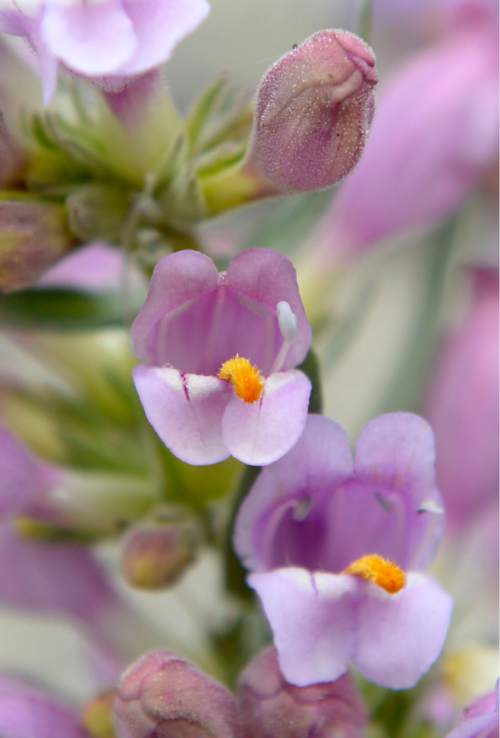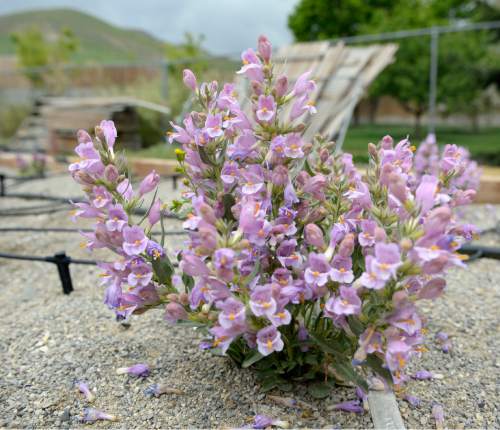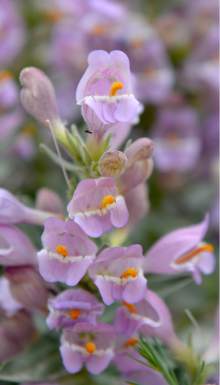This is an archived article that was published on sltrib.com in 2015, and information in the article may be outdated. It is provided only for personal research purposes and may not be reprinted.
The 31-year fight over Utah's beardtongue, rare wildflowers that grow only near the Uinta Basin's oil shale outcrops, is far from over despite a new conservation plan that state officials say ensures the plants survival should oil shale mining take off.
This week, the Utah Native Plant Society and other conservation groups formally accused the U.S. Fish and Wildlife Service of ignoring science and caving to political pressure from oil and gas interests when it withdrew a proposed listing for Graham's and White River beardtongue, also known as penstemon, under the Endangered Species Act (ESA).
The agency touted the conservation agreement as protection enough for the colorful flowers. The agreement calls for 300-foot buffers around the flowers within 44,000 acres of conservation zones.
But the 15-year agreement, crafted by Uintah County, federal and state officials is geared more toward ensuring the survival of the fledgling oil shale industry than of the basin's unique plant communities, said Lori Ann Burd, an attorney with the Center for Biological Diversity.
"Conservation agreements are great [because] they can move species toward potential recovery. This was hastily pulled together for the sole purpose of thwarting a listing," Burd said. "These beautiful and rare flowers are threatened with extinction, and all the government can muster is a strictly voluntary plan to keep them alive? That won't cut it."
Utah's School and Institutional Trust Administration, or SITLA, was a key player in the agreement because its holdings host the nation's most advanced oil shale projects.
"The agreement provides more protection than it would receive under an ESA listing" because it led to land-use restrictions on private and school trust lands, said John Harja, Utah's long-time pointman on public lands policy. "It's not voluntary. The county and SITLA have imposed ordinances that effectuate the terms."
Seven groups on Tuesday sent a notice of their intent to sue to the Interior Department, echoing criticisms environmentalists leveled in August when Fish and Wildlife holstered its proposal to list the plants.
At the time, the agency hailed the agreement as a "positive way forward for rare plant conservation."
"This decision [was] developed and made by local career employees of the Service working together with private landowners to ensure these amazing desert flowers remain for generations," wrote Michael Thabault, FWS assistant regional director, in an opinion piece submitted to The Salt Lake Tribune. "Private landowners, private energy companies, and SITLA all stepped up to make this an unprecedented conservation success story in Utah."
Fish and Wildlife spokespersons could not be reached Wednesday. Federal agencies typically will not comment on pending litigation.
In 2013, the agency proposed listing the two plants and identified 68,000 acres as critical habitat for Graham's and 15,000 acres for White River beardtongue. In addition to potential oil shale mining, the agency identified grazing, invasive weeds and drilling as threats.
The most recent surveys document 24 known populations of Graham's with 31,702 plants and seven White River populations with 11,423 plants, according to Fish and Wildlife.
The conservation agreement protects about two-thirds of these plants by barring disturbance within 300 feet of plants inside the conservation areas. It also limits total disturbance to 5 percent and 2.5 percent of the land inside conservation areas for Graham's and White River beardtongue, respectively.
"The idea was to protect the genetic variability of the plants by conserving these areas across the range," Harja said.
Critics, however, contend these standards have no basis in science and the conservation areas were carved out to exclude active oil shale proposals. "FWS improperly relies on unenforceable and uncertain future conservation measures contained in a last-minute conservation agreement to conclude threats to the species have been adequately reduced," wrote Burd and Robin Cooley, a lawyer with Earthjustice, in the notice.
The agreement "includes speculative promises of future protections that, even if implemented, are inadequate to protect the species from threats in the reasonably foreseeable future."
The groups also allege FWS' national headquarters meddled in regional staffers' decision-making process.
On Wednesday, Burd released an April 18 memo, obtained through the Freedom of Information Act, "recommending" that Colorado-based regional director Noreen Walsh withdraw her office's proposed beardtongue listing. Three weeks later, the agency reopened public comment on the proposal and released the draft conservation agreement.
Parties to the notice-of-intent-to-sue include Rocky Mountain Wild, Southern Utah Wilderness Alliance, Grand Canyon Trust, Western Resource Advocates and Western Watersheds Project. The groups say they will file suit in federal court in 60 days if the feds don't rectify what they say is a violation of the ESA.













